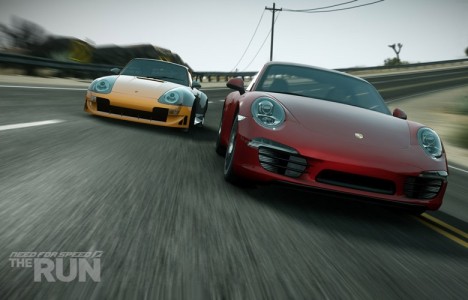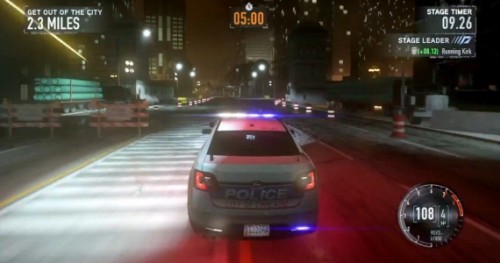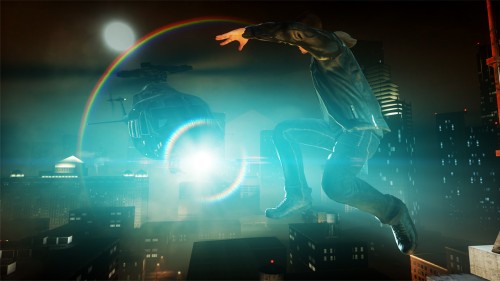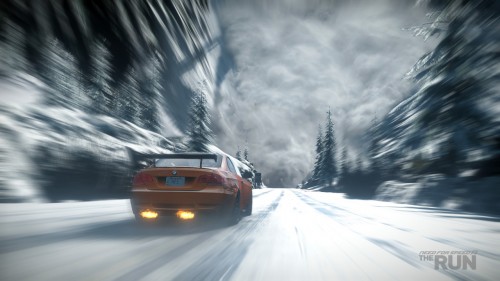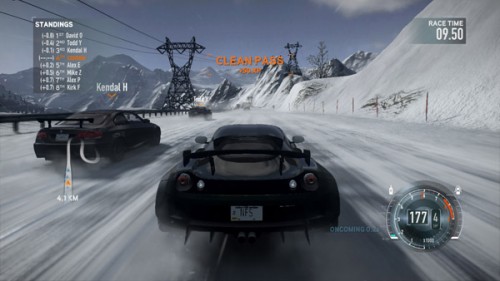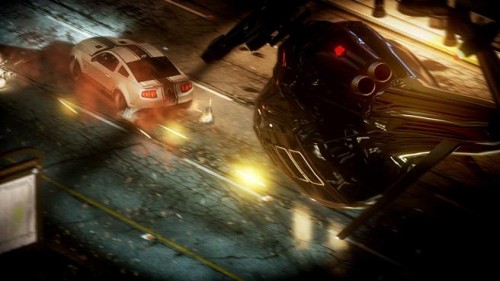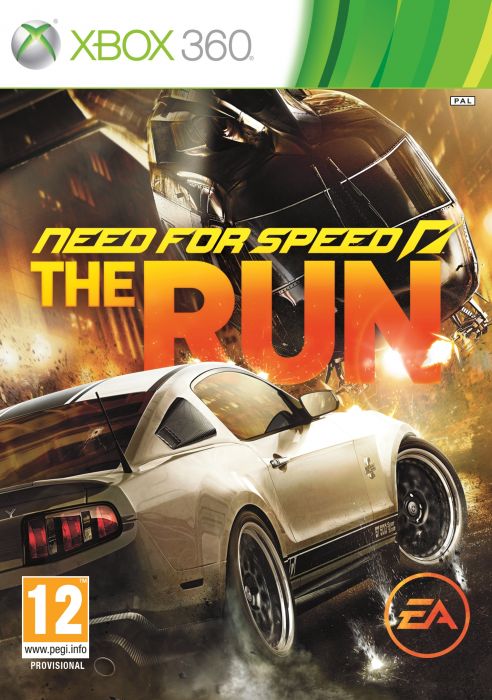
Need for Speed: The Run
Developer: EA Black Box
Publisher: Electronic Arts
Platform: Xbox 360 (reviewed), Playstation 3, PC, Wii
Release Date: November 17, 2011
Price: $59.99 – (Available Here)
Overview
Need for Speed games have been churning out yearly for quite some time now, but it’s been three years since the original Need for Speed team, Black Box Studios, have released a game on the market, with the two most recent entries in the series being “guest-developed”. Black Box are trying to come back with a bang: story is being brought back to the franchise, and along with it some of the most impressive set-pieces ever seen in a racing game. Does the adrenaline-fueled formula give The Run a straight shot of nitrous, or should it be dumped through a grinder?
Gameplay
Need for Speed: The Run comes packed with quite a few things to do, but the mode that sets it apart is, unsurpisingly, The Run. This singleplayer adventure tells the tale of Jack Rourke as he races across the United States to win a 25 million dollar prize. Why? Well, he owes the mob money, you see, and the mob tend to do mean things when they don’t get their money back.
That’s about as deep as the plot goes. You’ll “meet” other characters throughout the course of The Run via a description in the pre-race loading screen, and that’s all you’ll get. The plot merely exists to serve up the intense, adrenaline packed scenarios and tracks that occur during The Run, and though the context is hazy, the game makes you feel as if you are driving for your life; that it’s all on the line.
You start The Run in San Francisco below 200th place, and each stage provides different challenges to get you up towards the top spot. Some races will simply tell you to win against the racers on the stage, others will pit you in “battles” where you have limited time to pass single racers and maintain a lead before moving on to the next racer and repeating the process, and others will pit you in one-on-one races against the aforementioned “rivals” who will drive with more skill and far more agressively than the standard, AI drivers.
The game’s stages are really quite varied, and rather than making you memorize track layouts and perform laps, you’ll race from point A to point B across mountains, plains, cities, and deserts. Each stage allows you a certain number of “resets” should you crash, leave the track, or manually reset with the Back button. The checkpoints are generally generous, but on the larger, more elaborate stages the limited number of resets can definitely be a hassle, as running out sends you back to the beginning of the race. This wouldn’t be too problematic if load times for The Run stages weren’t so long. All you want is to get back into the race, but you’re stuck with a loading screen for 30 seconds; it kind of doesn’t mesh well with the action-emphasis of the game.
The Run is also extremely linear, and it suffers both the benefits and the pitfalls of that design. The benefits being that there is nothing more thrilling than racing through an avalanche, or being chased by policemen across San Francisco, or avoiding trains in the New York subway system. It’s seriously intense, and the much toted out-of-car sequences only serve to add to the intensity. These sequences occur about four times in the game, and each time for not much over a couple of minutes, but they essentially amount to quick time events where Jack must outrun cops, the mob, or anything else that wants to beat his face. They’re actually quite well done, and being stuck in a crashed car, trying to break out as a train hurtles towards you was definitely one of my favorite moments in the game.
But, the game is linear to a fault. The developers don’t want you going off the beaten path, and sometimes very harshly so. There were times when I’d round a corner and my left tires would leave the road and roll onto a hill or some dirt, and the game would send me back to a checkpoint, costing me a reset. While these moments occur rarely enough to cause serious damage to the overall experience, they are there and they are very frustrating.
On top of that, you don’t get the option to switch cars before a race starts while playing through The Run; you have to stop at designated gas stations to change rides, and this can often have a negative impact on your race position. And while the autolog feature returns from previous title entries so that you can compare stage times with friends, you can’t simply go back to individual races to try and improve your time. If you want to, say, replay the avalanche sequence, you’ll have to start at the beginning of the mountain sequence and play through every track leading up to it.
These odd design decisions hamper The Run’s gameplay, and it seems strange that such miscues were overlooked. The Run will take you about five to seven hours to complete, and aside from some of the frustrating mechanics, the game succeeds in capturing the blockbuster action of a summer movie, and it will keep you on the edge of your seat.
But The Run isn’t just about The Run. The game’s other singleplayer option are the challenge maps, which unlock as you complete The Run mode. These use a variety of the locations from the campaign and twist them with new objectives and race types. Each track has 4 types of medals you can earn; the faster you finish, the better the medal. The times on these tracks are also uploaded to Autolog, and, as there are over fifty, they should provide plenty of additional game time to leaderboard addicts.
The game also comes with solid Multiplayer content, which, much like the singleplayer, sacrifices options, for simple, edge-of-your-seat action. You can choose from playlists which suit the kind of driving you want to do and what car you’ll be racing in, and the game does the rest. To encourage people playing together for a while, creating a sort of mini-community, each track offers group and solo objectives which give bonuses in XP to the players. And when the tracks in a playlist have run out, the players can vote on what playlist they’d like to go through next.
The Run features a profile levelling system to keep you into the game. Experience can be earned via both singleplayer and multiplayer, and level progression will unlock new ways to build up nitrous as well as profile icons and backgrounds which are shown off whenever you win an online race. The Multiplayer portion of the game, despite lacking the over-the-top setpieces of the campaign, can be just as intense because you’re not playing agaisnt squeaky clean AI players.
Players will knock each other off cliffs, crash through civilian traffic, and occasionally a group of five people will miscue a turn and all fly into a river at the same time. It’s mayhem, and boy is it fun. And because Multiplayer is required to unlock certain high-end cars for use in other modes, there’s plenty of incentive to keep playing.
Audio
Need for Speed: The Run seeks to emulate summer blockbuster films, and it does so excellently in the sound department. Epic orchestral themes will sweep you through the game’s major setpieces and tracks, and when those go away, they’re replaced by an outstanding array of quality music, mostly Rock, and thankfully, not a whisper of dubstep, rap, or electro. Someone at Black Box has good taste in music.
The voice acting does it’s job, not that people speak a lot. Christina Hendricks, of Mad Men fame, plays your sponsor and advisor via phone line, while Jack replies with grunts and “yes”s.
Voice acting aside, The Run’s audio effects are just spectacular. The roar of the engines, the wind blazing past your speeding car, the crash of metal on metal; it all feels real and visceral, and it just adds to the overall intensity of the experience.
Visual
There was a little game called Battlefield 3 that came out earlier this year, and it looked great because it used a powerful, new graphics engine. Well, the Frostbite 2 engine is back, baby! And it’s gorgeous.
If you can’t actually drive across America, this is the next best thing. Everything from the lighting, to the game’s grand vistas, to the way cars move on the road looks amazing. There’s occasional pop-in and some of the textures can be a bit blurry when you look closely, but overall, the game looks fantastic. And though there’s no emphasis on Frostbite 2’s destructibility capabilities like in Battlefield, there’s a very dynamic feeling to the way you’ll crash through wooden barriers and crates. The Run wants to emphasize blockbuster action, and looking this good does it a great many favours in that department.
Overall
Need for Speed: The Run is a game with issues. Some off-kilter design decisions and the frustrating linearity of it all can majorly detract from the experience, and the story isn’t something you’ll tell your kids about.
In the end, that’s not a flaw. Need for Speed: The Run is the Call of Duty of racing games. Sure the plot is paper thin, but you’ll be on the edge of your seat more often than not. As you guide your car through mobster gunfire, weave through exploding steel mills, or escape the police in Las Vegas, the game is an intense, non-stop action experience that manages to satiate the adrenaline junkie in me.
If you’re looking for a racing simulation, The Run isn’t for you. But if you’re after thrills, spills, and a driving experience that’s all about action, then you don’t have to look any further. This is the game for you.



